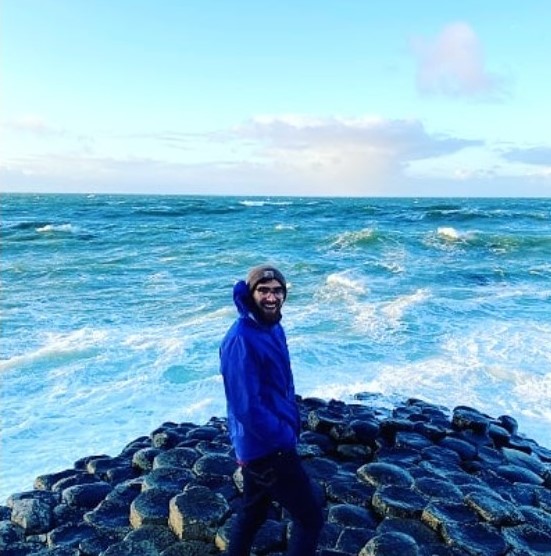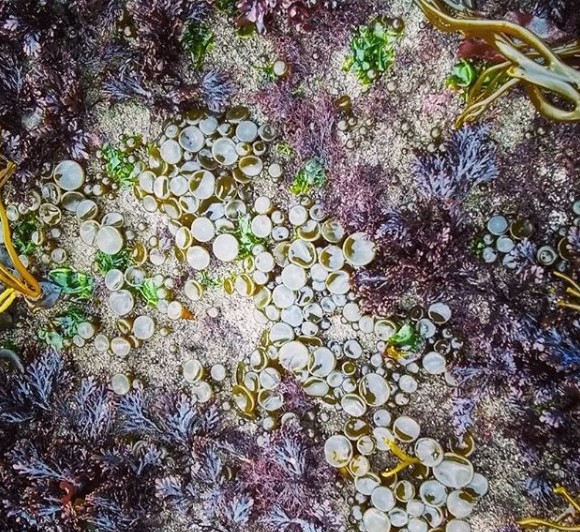Augustus Pendleton – Picking Carraigín
Augustus Pendleton graduated from the University of Minnesota Twin Cities with an undergraduate degree in Microbiology. Interes ted in how aquaculture can be a sustainable complement to terrestrial agriculture, Augustus undertook the M.Sc. in Geography at NUI Galway 2019-2020, researching community member’s attitudes concerning sea plant harvesting along the west coast of Ireland.
ted in how aquaculture can be a sustainable complement to terrestrial agriculture, Augustus undertook the M.Sc. in Geography at NUI Galway 2019-2020, researching community member’s attitudes concerning sea plant harvesting along the west coast of Ireland.
“Water has already sloshed into my wellies, soaking my socks and numbing my toes. I am on one of the Aran islands, learning to harvest seaweed and today we are picking carraigín, a short shrubby seaweed at most 12 cm high which clings stubbornly to rocks at low tide. I wade through small pools, stepping carefully on the slick rocks, bending down to snip the small seaweed off the rock and slowly fill a bushel basket. The January sky is a luminous grey but fails to lighten the ocean beneath it; blue-black waves break on burnt-grey karst, sending plumes of spray and froth into the air. As a Wisconsinite I was raised to handle the cold, but the Irish winter’s combination of Atlantic wind, damp sea spray, and clouded skies can be uniquely savage.
The seashore itself, however, stands in earnest defiance of this beautifully grim landscape. Carraigín and dillisk smolder with warm reds, while ephemeral sheets of Ulva are smears of neon green, and Himanthalia buttons scatter like spilled olives. Thick swathes of dark Ascophyllum conceal hundreds of vibrant yellow periwinkles. Submerged in deeper waters, the golden fronds of Laminaria species undulate. The violent storms of Ireland’s west coast wrench these kelps from the rocks and toss their stipes on the beach, where these slataí mhara surrender a dying crunch of orange.
I have come to this country from the dairy farms and freshwater lakes of my Midwest home to study these seaweeds and the people who harvest them. I have ridden Bus Eireann back and forth across Connemara and have done my best to immerse myself in the culture, language, and humour of Co. Galway. I have heard stories of struggle and hardship, and seen first-hand the awe-inspiring entrepreneurship, innovation, and most importantly, hard work which to me defines Western Ireland. Mostly, if we are being honest, I have gotten rained on. A lot.
Fittingly, a light drizzle begins to fall, and we decide we have harvested enough seaweed for now. The rest of the day is dedicated to a hearty lunch in a local café, a nd hot tea, and warm conversation. I stumble through my Irish ordering lunch, enormously proud of the phrases I manage to piece together and grateful the owner is so patient with my attempts. Most of my research involves listening patiently, deeply; I record interviews to analyse later. It is humbling work, in that I only gather and share the knowledge of others, an outsider seeking to understand a lifetime connected to the shore in the span of a two-hour interview.
nd hot tea, and warm conversation. I stumble through my Irish ordering lunch, enormously proud of the phrases I manage to piece together and grateful the owner is so patient with my attempts. Most of my research involves listening patiently, deeply; I record interviews to analyse later. It is humbling work, in that I only gather and share the knowledge of others, an outsider seeking to understand a lifetime connected to the shore in the span of a two-hour interview.
These islands will be bustling in spring and summer, but in January they are wonderfully empty except for those who live here. The hostel in which I am staying is technically closed for the season, but the owner was generous enough to let me in for the weekend. As the only guest, I have free rein of the kitchen and common areas, no staff are present, and the owner left for the weekend. A storm comes in this night, whipping fat drops of rain against the roof and wrinkling the surface of the harbour like a crumpled tissue. I sit alone in the kitchen, watching rivulets of rain stream down the windows and eating biscuits which are heartbreakingly unavailable in America. The steam from a cup of tea drifts through the cool blue light of my laptop screen, the white of a document reflecting across my glasses. Over the next four hours I transcribe interviews from the day, dutifully copying every word and pause, trying to indicate through punctuation the unique cadence of Irish-English which still trips me up as an American.
It is a curious scene; I am hermetically sealed in an empty hostel, isolated by the wind and far from home, but the room is filled with conversation and laughter, recorded in the sun and fed through my earbuds. This night remains one of my favourite memories of Ireland, carried home carefully in the chaos of COVID-19, kept safe from the blazing sun and 35℃ weather of Virginia, where I live now. And when I need it, I can close my eyes, hear the waves breaking on the shore, the rain lashing the windows, the wind howling over the cliffs, and return to the peace of being alone on a stormy Atlantic night.”
